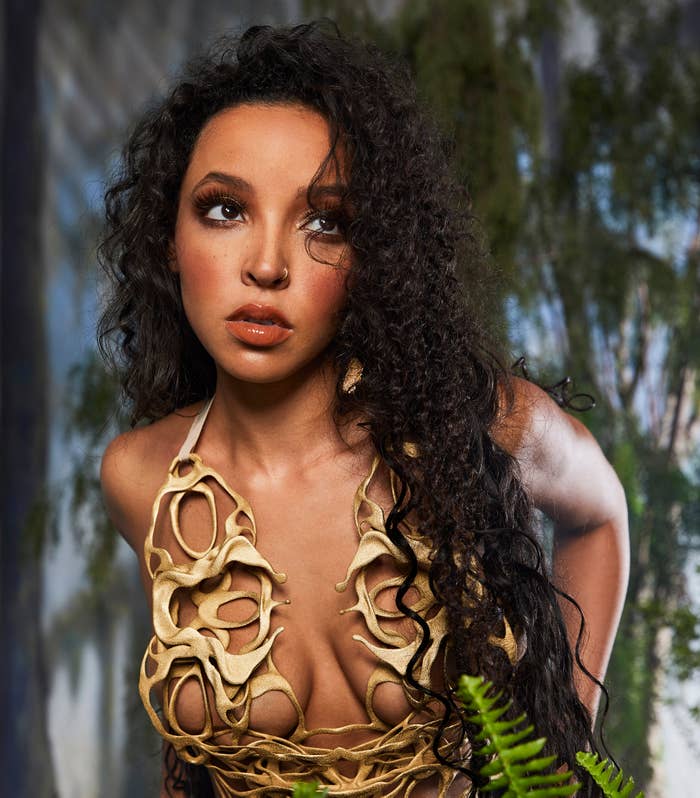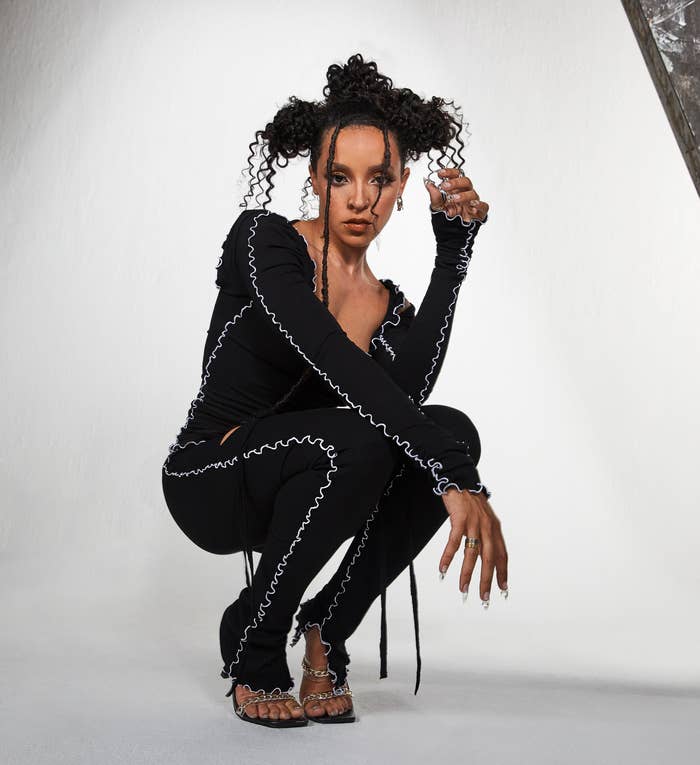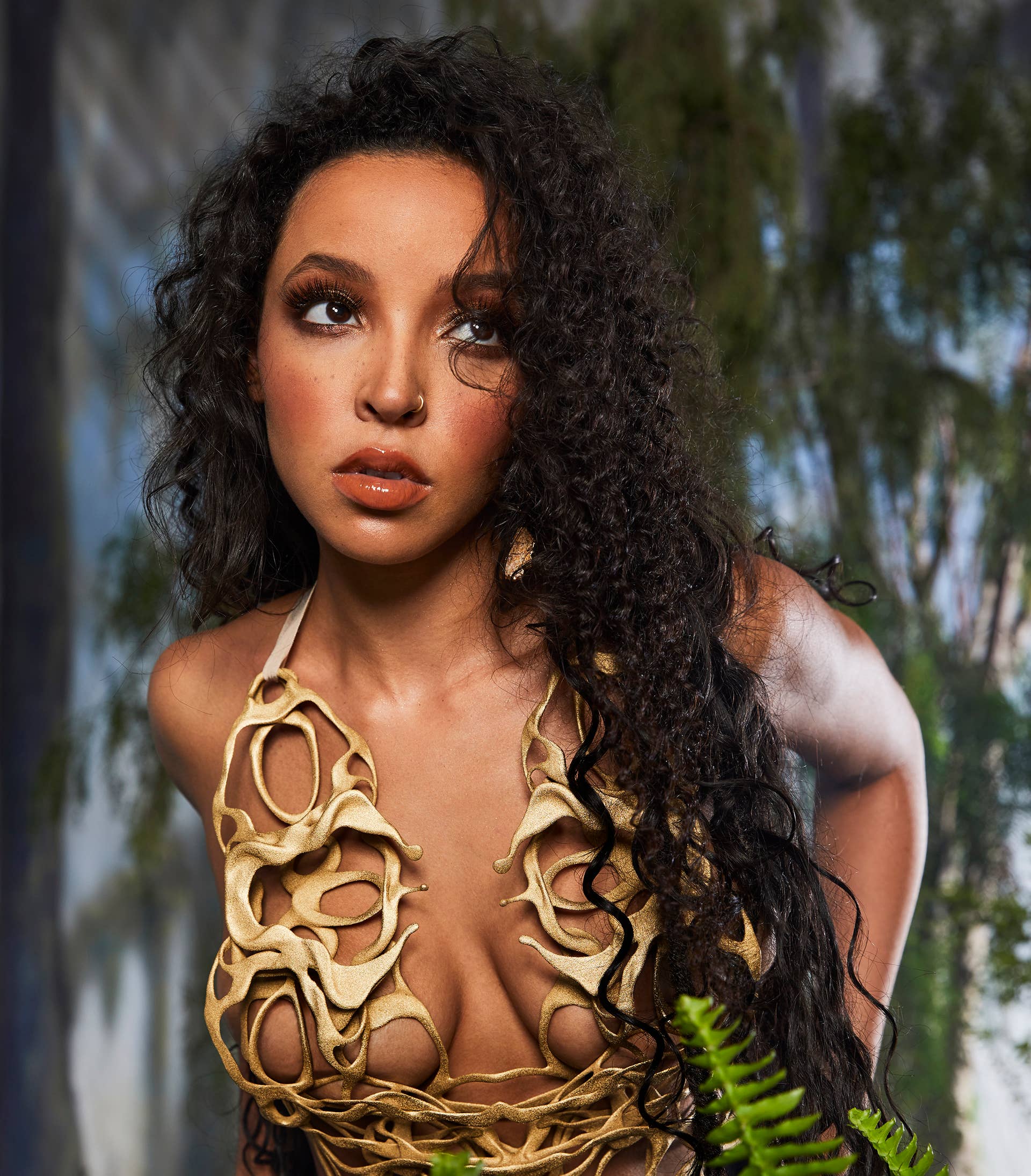
I see two sides of Tinashe during her show at Terminal 5 in Manhattan on Sept. 30.
I witness one of them backstage before her performance, as she kicks back on a couch in a wool jacket and other comfy attire, moments before her first headlining set in New York as an independent artist.
The other side of Tinashe—the one that comes to life the second she steps in front of a crowd—is present for the entirety of her set, especially during her “Bouncin” trampoline routine, when she drops to the floor on her hands, grabs hold of a mini-trampoline, springs her knees around in coordination with her dancers, and thrusts to the sky.
“I think I black out during that part,” she jokes.
Tinashe, who has finally been able to unleash that second side of herself during her journey around the US on the “333 Tour,” is completely in her element throughout the show, to the point where she doesn’t even notice a fight break out between two women in the middle of “Link Up.” The way she dances through it proves that it’ll take a lot more than an offstage tussle to stand in the way of one of today’s most charismatic performers putting on a show. And as Tinashe will tell you herself, when you watch her concert, you’re watching a pop star at work.
“It’s great to be back,” she says, grateful for a return to the stage after a string of pandemic-driven virtual gigs throughout 2020. “It’s great to feel the crowd. It’s just way better than those virtual performances.”
Before the gig, we caught up with Tinashe to discuss her latest album 333, her admiration for Janet Jackson, the many Tinashe references in hip-hop, and why she “hated being called an R&B star.”

You re-created the “Bouncin” music video experience with the trampolines onstage tonight. How crucial was it to use elements from these visuals on tour?
I just wanted to incorporate a lot of the same energies; whether it be sonically with the band element or visually with the screens, the lights, and the dancing. I touch on a lot of the different art that we’ve done, as well as the cover art with the greenery and things that we’re placing around the stage.
That video sparked a lot of “Tinashe is underrated” comments on Twitter, but you recently said you’d rather see yourself as a “legend in the making.” Does independence give you an extra push of confidence to know that you’re on that trajectory?
Being independent is very fulfilling for a lot of reasons. There are definitely times where it feels harder, and when it feels like a little bit more of an uphill battle. But at the same time, it’s fulfilling to know that I am doing this independently and still able to make my mark and tour and do all these things after all these years and continue my career. It’s encouraging and exciting. It’s definitely more fulfilling.
Is that how you normally see things? That you’re building this legacy with each passing record, whether it be Songs For You or 333?
I focus on the legacy aspects of my career and what I want to achieve in the long term. I think of my career as a long game. It’s something I want to do for a long time, and not just like, “OK, how can this song be the biggest song or this album be the biggest album?” I think my goal posts are a little bit more generalized and a little bit more long term than they used to be. And that’s been helpful.
“I hated being called an R&B star. I’ve always honestly classified myself as a pop star.”
333 has some of the dark R&B that we heard so much of on Nightride, and still manages to deliver the bigger pop bangers with “Undo” or “The Chase.” What do those poppier moments mean to you on a Tinashe record?
That’s who I am, and that’s who I am as an artist, so I think that it just feels really natural. Because I made the records, I don’t know. I don’t like to think strategically and be like, “We need a dark one, and a poppy one.” I just make what feels right to me and it ends up being the outcome.
I’ve read a lot of your older interviews, and early looks with Aquarius had you labeled an R&B star. I know “No Drama” had you calling yourself a pop star, but do you use labels like that at this point in your career?
I hated being called an R&B star. I really, really had a strong aversion to that. I felt that created a ceiling to my art and my artistry that really turned me off in the early days. I didn’t want to be in that box that I felt had some type of inevitable lid on it. I’ve always honestly classified myself as a pop star. That’s always been what I see for myself, and then I think people’s interpretation of what that means is maybe where it gets convoluted, because some people think pop means mainstream. Like, I don’t know, Taylor Swift, Katy Perry, or something. But I think that’s not what that really means. To me, it’s more like what you embody more so than, I think, what it sonically sounds like.
Looking at the crowds on this tour, do you feel this album, in just two months, has managed to touch people the way you intended?
I’ve been very thrilled with this response. People have been coming up and telling me how much the art means to them, how much it’s gotten them through the past few years. I think that’s all you can ask for as an artist—that what I use as some type of cathartic demonstration of my feelings is felt by other people. That’s the dream. So it’s very cool to see, I think it’s definitely translated.
In 2019, Complex ranked the best rap verses of the year, and Pusha-T clocked in at No. 1 with the “Palmolive” verse that references diamonds dancing and doing “the Tinashe.” Why do you think you’ve become such a great reference point in hip-hop lyrics?
I think that the most impressive thing about my career is the fact that I’ve been able to do this for so many years and continue with the same energy, vigor, and preparation since the beginning. It’s hard to maintain, for a long time, in this industry. It’s kind of dark. It can really fuck with you. And so I think that people, like my peers and a lot of people that maybe have referenced me, have seen me be a part of culture for a while. And that means a lot. So I love to see whenever I’m referenced, and there’s little things that appear on people’s mood boards or in people’s songs, things like that. Every time that happens, I’m like, “I did what I came to do.”
Each music video you put out becomes a moment of its own. Do you think there’s always going to be a space for that level of choreo in music videos?
If people keep creating this space for it. I mean, I definitely think when I got in the game, there were not many people that were doing choreography. I mean, people have in the past. But there was an era where people kind of stepped away from that. People used to say it wasn’t cool or it was corny. And it always felt really natural to who I am, and also what I loved about artists that I grew up with. So it was always really important for me to bring that to the next generation. It’s exciting to see so many other people doing it now. But yeah, it’s all up to the artists to continue to bring that into the future.
Is there anybody in your Rolodex of inspirations choreography-wise, who you’d like to pick their brain?
I’ve never really thought of that before.
I was going to bring out the Janet T tonight.
Janet is amazing. I can’t even imagine picking her brain. Well, [on] choreography, that would be amazing. I suppose the way that she integrates it into all of her visuals as well as her live show, and takes it so seriously. I think it’s that level of attention to detail and taking it all very serious. I’d want to pick her brain about it.
This is your first time headlining New York as an independent artist. Is there a more personalized feeling to live shows when you’re now playing two albums that were all completely you?
I think I’m just in the era right now where it feels like everything is very authentic. And that’s really nice to get the kind of response to that authenticity coming through, because I don’t think I 1,000 percent really knew what to expect when making that transition.
You’ve said that SFY taught you to trust your instincts. Did that experience help you feel more prepared or confident, going into your second independent release?
Everything that I’m doing at this point is just basically instinctual, or just like a vibe, because yeah, I don’t have to answer to anyone or make any adjustments creatively to literally anyone.
What’s been the most important takeaway from 333 and this tour so far?
I’m just trying to really live in the moment and be in the moment now, and appreciate every step of the way. Because I do think that there was some time in the early days of my career—I’ve always been very appreciative—but there were moments where so much was happening. I’m so busy traveling. Just taking a second to really try to take it all in every day, is probably the biggest takeaway. Just being really viscerally in every moment.



